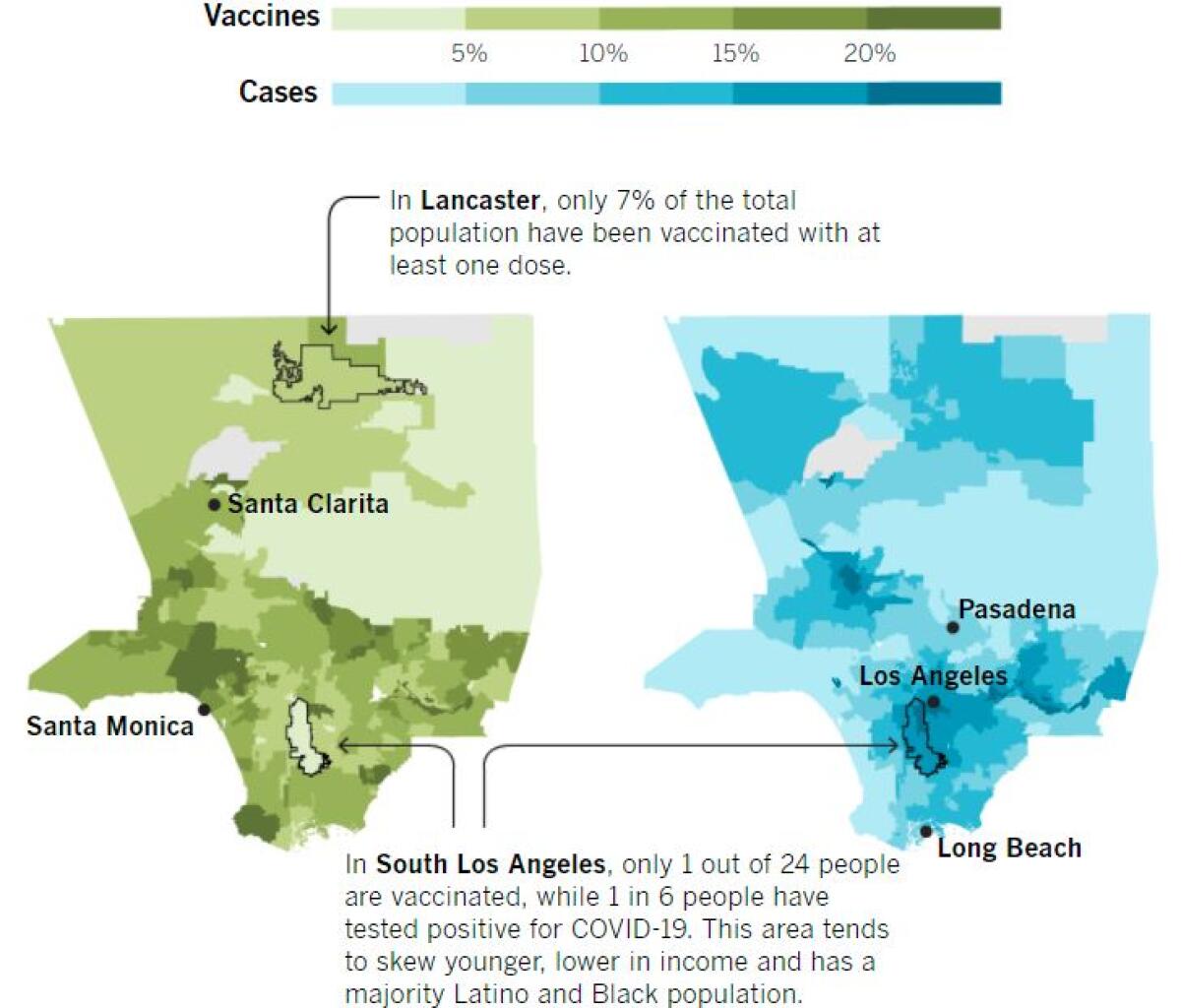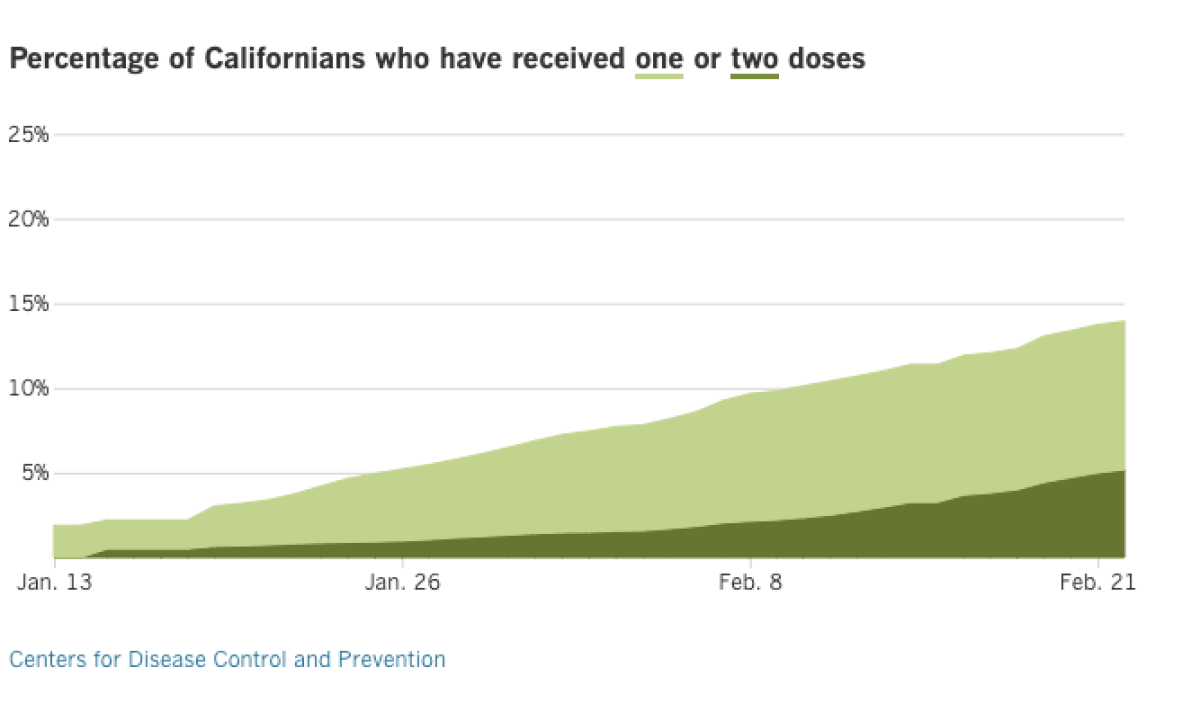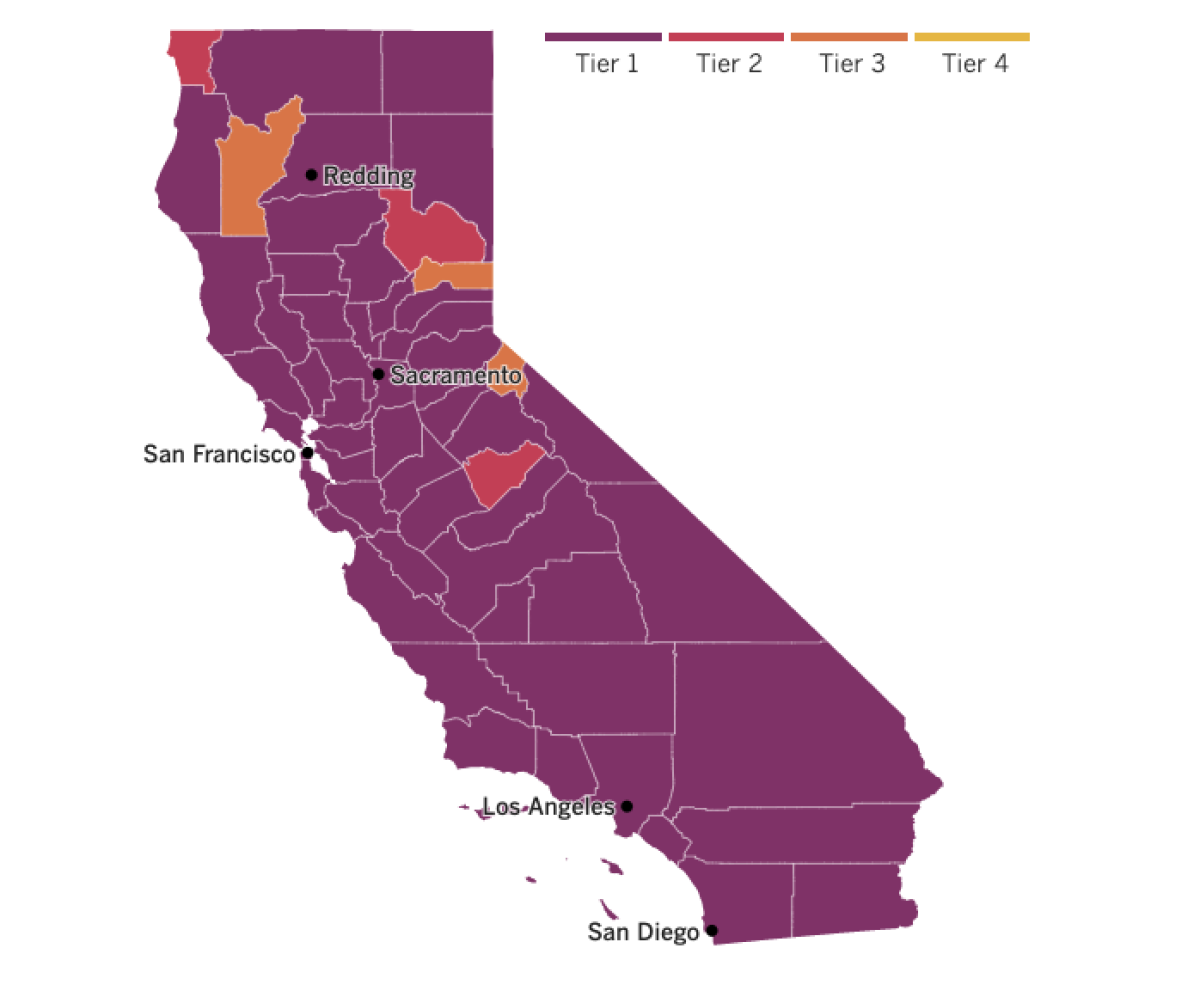Coronavirus Today: Is it time for some optimism?
Good evening. I’m Thuc Nhi Nguyen, and it’s Monday, Feb. 22. Here’s what’s happening with the coronavirus in California and beyond.
Last spring, Gov. Gavin Newsom told Californians we couldn’t return to the 2019 version of normal “until we have herd immunity.” At the time, we were just beginning to settle into our first stay-at-home order, making face masks out of T-shirts and still getting used to eyeballing six feet of distance.
It seemed like a far-off dream to reach the point where so many people had immunity to the coronavirus that it would stop spreading because it couldn’t find new hosts. But nearly a year later, that goal might be coming into focus, my colleagues Soumya Karlamangla and Rong-Gong Lin II report.
With coronavirus cases plummeting and vaccinations increasing, “we’re really talking something starting to sound and look like herd immunity,” said UC San Francisco epidemiologist Dr. George Rutherford. “Although that true herd immunity is a ways off in the future.”
Scientists are still unsure of the exact threshold that will be necessary to reach herd immunity against the coronavirus. Some estimate it could happen when 50% of people are immune; others think the figure is closer to 90%.
Each day that new infection rates decline and vaccination rates rise is a day that gets us closer to the goal, though coronavirus variants could slow that progress if they’re more resistant to vaccines or spread more easily. Shifts in behavior could also render the good news moot. Experts continue to stress the importance of following COVID-19 protocols like wearing masks and social distancing. “I don’t want to provide a false sense of assurance here,” said Dr. Paul Simon, L.A. County’s chief science officer.
Researchers at USC estimate that 33% to 55% of people in L.A. County have been infected with the coronavirus, after an autumn and winter surge that killed more than 12,000. Many of the cases were concentrated in low-income neighborhoods, disproportionately affecting Black and Latino people. The uneven geographical distribution of infections may leave some pockets of the county more vulnerable than others, Simon said.
Inequities in vaccine distribution have also been a concern. My colleagues on the data desk showed how the geography of infections intersects with vaccinations by parsing data from the L.A. County Department of Public Health.
Their maps show that the areas with the highest case rates also have some of the lowest vaccination rates.

For example, 25% of Beverly Hills residents have received the first dose of a two-shot vaccine. In South L.A. and neighboring cities like Compton, where incomes are lower and a majority of residents are Latino, only 5% of residents have been vaccinated.
Numbers like those “clearly indicate very significant inequities in the distribution of vaccine to date,” Simon said. “These inequities are unjust and unacceptable and demand renewed efforts to address them.”
The Times has been tracking the coronavirus outbreak across L.A. County and throughout the state for nearly a year, counting up more than 3.5 million infections and nearly 50,000 deaths. Now our tracker is available in Spanish as well as English.
By the numbers
California cases, deaths and vaccinations as of 4:26 p.m. on Monday:

Track California’s coronavirus spread and vaccination efforts — including the latest numbers and how they break down — with our graphics.

Across California
We’ve spent more time at home than ever in the past year, and for some people, it’s made them realize that their home is not where their heart is.
In places like San Francisco, many renters have abandoned their crowded and expensive city apartments to find more space elsewhere. As a result, the average rent for a one-bedroom apartment in the city has fallen nearly 30%. That’s the largest such drop in the country.
In fact, the steep drop has resulted in a surprising switch: The city has become more affordable than Oakland, my colleague Liam Dillon writes.
Now there are tech workers who can ditch their roommates in Oakland for solo apartments in the heart of San Fran and even recent college graduates who can afford to live alone. San Francisco landlords are slashing prices for new tenants and offering incentives like free cable and internet, pre-loaded debit cards and personal training sessions.
The beneficiaries are largely middle- and upper-income earners. After all, a one-bedroom apartment in the city still rents for almost $2,000.
Meanwhile, in L.A.: City-run vaccination sites will resume Tuesday after severe weather elsewhere in the country delayed shipments and postponed thousands of appointments.
The city’s large-scale sites were forced to close Friday and Saturday because at least 63,000 doses of COVID-19 vaccine bound for L.A. were mired in winter storms. But with more than 92,000 doses of Moderna’s vaccine on their way, the city started rescheduling appointments with an emphasis on administering second shots.
Those who were originally scheduled for Friday and Saturday will be prioritized and should have received updated appointment details by late Monday. Residents who got their first dose at a city site between Jan. 24 and 30 will receive their second-dose appointment details by the end of Tuesday.
Ventura County is now vaccinating farmworkers as part of a pilot program geared toward the region’s large agricultural sector, with teachers, child-care providers and first responders slated to come next.
And this week, Orange County will start setting aside 30% of its vaccine allocation for workers in education, child care and food and agriculture. The remaining 70% will be reserved for people 65 and older.
Orange County has struggled with supply issues that kept the distribution site at Disneyland closed Monday. And shipment delays might force the county to postpone Wednesday’s launch of a new site at the Anaheim Convention Center.
The new sites opening across the state are part of a system that could administer as many as 4 million doses of vaccine per week, Newsom said. The problem is that California is receiving only about 1.3 million doses per week.
The governor, who spoke Monday at a vaccination site in Long Beach, praised that city’s vaccination plan, which includes priority access for educators and food and grocery store workers. As a result, the city, which has its own public health department separate from L.A. County, plans to reopen schools for its youngest students March 29. Newsom said he wanted to “encourage that to be replicated all throughout the state of California.”
Los Angeles schools are inching toward reopening. Supt. Austin Beutner announced Monday that LAUSD campuses will begin offering child care, one-on-one and small group instruction, services for students with special needs and a return to athletic conditioning for high school athletes. He anticipates a more complete reopening of schools in April.
For some, that’s not soon enough. Parents organized a protest Monday outside the Federal Building in West Los Angeles as their children participated in a “Zoom blackout.” The strike from attending school online will continue “for as many days it takes,” organizers said.
When kids do return to school in LAUSD, roll call may look a little different, thanks to a COVID-19-tracking app that will generate a unique QR code to let every student and staff member enter campus. Beutner said Monday that the app will help officials quickly isolate anyone who has contracted the virus and will be key to keeping students and staff safe by coordinating health checks, coronavirus tests and vaccinations.


See the latest on California’s coronavirus closures and reopenings, and the metrics that inform them, with our tracker.
Consider subscribing to the Los Angeles Times
Your support helps us deliver the news that matters most. Become a subscriber.
Around the nation and the world
The United States passed yet another grim milestone Monday as the nation’s COVID-19 death toll eclipsed 500,000. That’s more fatalities than the combined U.S. battlefield deaths in both world wars and Vietnam, my colleagues report. It’s as if all the people in Atlanta vanished.
“It’s nothing like we have ever been through in the last 102 years, since the 1918 influenza pandemic,” said Dr. Anthony Fauci, the nation’s top infectious disease expert. The U.S. had 675,000 deaths then, but the total was small compared to the worldwide toll of 50 million.
During the COVID-19 pandemic, the U.S. has reported about 20% of the world’s deaths, which number nearly 2.5 million, despite the fact that Americans account for 4% of the world’s total population.
Though the numbers are staggering, the pandemic’s darkest hours may be behind us. New cases are falling in the U.S., and the vaccine rollout, despite sputtering at times, is trending toward success. Experts are keeping an eye out for the viral variants circulating around the world, though.
At least one of those variants has proved to be less susceptible to the initial crop of COVID-19 vaccines, and more could follow suit. That has prompted vaccine makers to work on modified versions of their products, and the U.S. Food and Drug Administration issued guidance Monday on its streamlined process for vetting modified vaccines.
The new approach is intended to speed up the regulatory review process, my colleague Amina Kahn reported. After all, this time they’re not starting from scratch.
Dr. Peter Marks, director of the FDA’s Center for Biologics Evaluation and Research, said trials to test the immune response prompted by a modified vaccine could involve a few hundred individuals and take two or three months. That’s a stark difference from a typical Phase 3 clinical trial, which can take several months more and require tens of thousands of participants.
The speed at which scientists developed initial COVID-19 vaccines was a source of concern for some people who questioned whether faster also meant safer. But when it comes to the quick process of altering a vaccine, it’s the norm for viruses like influenza, said Dr. Diane E. Griffin, a viral immunologist at the Johns Hopkins Bloomberg School of Public Health.
The two vaccines currently authorized for use in the U.S. are still effective against the mix of variants now circulating in the country, the FDA noted.
While the United States is working to vaccinate people as fast as it can, countries that have had more success keeping their outbreaks in check are beginning to roll out the shots in a more deliberate way.
Australia on Monday started inoculating health and border-control workers and nursing home residents and staff in the first steps of its vaccination program. The country of 25 million people has reported just 909 COVID-19 deaths.
Catherine Bennett, an epidemiologist at Australia’s Deakin University, said countries not in the midst of a coronavirus crisis have benefitted from taking their time and learning from others.
“We’ve now got data on pregnant women who are vaccinated. Natural accidents, like incorrect dosing, happen in a real-world rollout,” Bennett said. “All of those things are really valuable insights.”
Your questions answered
Today’s question comes from readers who want to know: Is it dangerous to get a COVID-19 vaccine while you have an active coronavirus infection?
This is a plausible scenario, because it takes a few days for an infection to take root and make someone feel sick. In many cases, people who are infected never develop symptoms of COVID-19 and don’t realize the virus was in their bodies. The U.S. Centers for Disease Control and Prevention estimates that 40% of people with coronavirus infections are asymptomatic.
That said, this isn’t a problem that keeps infectious disease experts up at night. There has not been much research to determine the effects of vaccination on people with active infections, but there’s no reason to think it should be a significant cause for concern.
“If we were extremely concerned about this, we would require everybody to get a COVID test before they got vaccinated,” said Shira Shafir, an epidemiologist at UCLA’s Fielding School of Public Health. “And that’s not a policy.”
Indeed, the CDC’s guidelines state that “viral testing to assess for acute SARS-CoV-2 infection … for the purposes of vaccine decision-making is not recommended.” The emphasis on “not” comes straight from them.
The reason you don’t have to worry about interactions between a COVID-19 vaccine and an active infection goes back to the way the vaccines going into Americans’ arms prime the body to respond to an infection.
“When we have natural infection or when we get the vaccine, the part of the virus that our body will see is the spike protein,” Shafir explained. “Then our body says, ‘Well, that doesn’t belong here, let me make a response to try and deal with this spike protein, to neutralize it or kill the infected cell.’ So even if someone is asymptomatically infected and they get the vaccine, all that’s happening is their body is being presented with more spike protein to which to respond.”
Although it’s not dangerous for infected patients to receive the vaccine, those who have confirmed cases of coronavirus infection, whether they are asymptomatic or not, should be isolating themselves per CDC guidelines. That includes staying home instead of going to a vaccination center, where they could wind up infecting people around them.
We want to hear from you. Email us your coronavirus questions, and we’ll do our best to answer them. Wondering if your question’s already been answered? Check out our archive here.
Resources
Need a vaccine? Keep in mind that supplies are limited, and getting one can be a challenge. Sign up for email updates, check your eligibility and, if you’re eligible, make an appointment where you live: City of Los Angeles | Los Angeles County | Kern County | Orange County | Riverside County | San Bernardino County | San Diego County | San Luis Obispo County | Santa Barbara County | Ventura County
Practice social distancing using these tips, and wear a mask or two.
Watch for symptoms such as fever, cough, shortness of breath, chills, shaking with chills, muscle pain, headache, sore throat and loss of taste or smell. Here’s what to look for and when.
Need to get tested? Here’s where you can in L.A. County and around California.
Americans are hurting in many ways. We have advice for helping kids cope, resources for people experiencing domestic abuse and a newsletter to help you make ends meet.
We’ve answered hundreds of readers’ questions. Explore them in our archive here.
For our most up-to-date coverage, visit our homepage and our Health section, get our breaking news alerts, and follow us on Twitter and Instagram.




